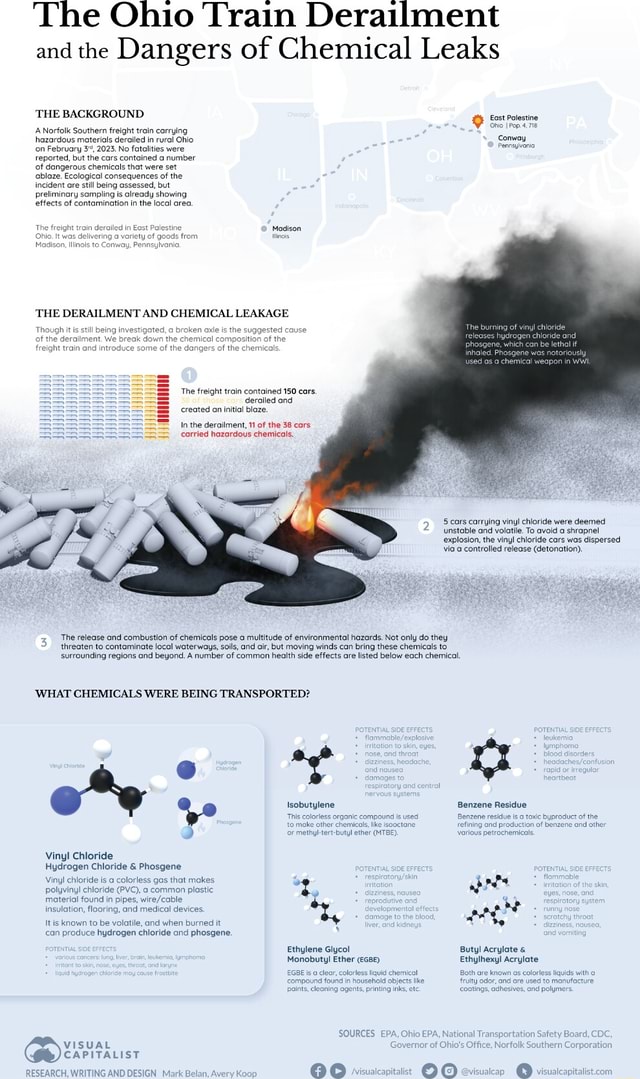Months-Long Chemical Residue In Buildings After Ohio Train Derailment

Table of Contents
Types of Chemicals and Their Persistence
The derailment released a cocktail of hazardous chemicals, most notably vinyl chloride and butyl acrylate. Vinyl chloride, a known carcinogen, is associated with an increased risk of liver cancer, brain cancer, and lung cancer. Butyl acrylate, an irritant, can cause respiratory problems, skin irritation, and eye damage. These are not the only harmful substances released; the full extent of the contamination is still being investigated.
The persistence of these chemicals is a major concern. Their longevity depends on several factors, including:
- Chemical properties: The inherent stability of the chemicals influences how quickly they break down.
- Building materials: Porous materials like drywall, carpet, and insulation readily absorb these chemicals, making complete removal challenging. Non-porous surfaces may also retain residues.
- Environmental conditions: Temperature, humidity, and air circulation affect the rate of chemical degradation and volatilization.
Studies on the half-life of vinyl chloride and butyl acrylate in various building materials are crucial, but data is still emerging. The potential for bioaccumulation – the gradual build-up of chemicals in living organisms – further exacerbates the long-term health risks associated with persistent organic pollutants like these. Understanding the environmental contamination and the chemical half-life is paramount for effective remediation.
Health Impacts on Residents and First Responders
Residents and first responders in the affected area have reported a range of health issues, including:
- Headaches
- Respiratory problems (coughing, shortness of breath)
- Skin irritation
- Eye irritation
- Nausea
The long-term health risks associated with exposure to vinyl chloride and butyl acrylate are significant, potentially leading to cancer and other chronic illnesses. Comprehensive data on the number of reported illnesses is still being collected and analyzed. The lack of immediate and readily available data highlights the need for increased environmental health monitoring and support for affected individuals. This situation underscores a significant public health crisis, demanding immediate and sustained attention. The health of first responders, often exposed to higher concentrations of these chemicals, requires specific and dedicated long-term monitoring.
Challenges in Cleanup and Remediation
Removing months-long chemical residue from buildings presents significant challenges. Identifying the extent of contamination requires advanced testing and sophisticated analytical techniques. Remediation strategies might include:
- Air scrubbing: Removing contaminated air from buildings.
- Surface cleaning: Decontamination of affected surfaces using specialized cleaning agents.
- Specialized waste disposal: Safe disposal of contaminated materials according to strict environmental regulations.
The financial and logistical hurdles associated with large-scale cleanup efforts are considerable. The sheer number of potentially affected buildings and the need for specialized expertise and equipment make this a complex and costly undertaking. Furthermore, ensuring the effectiveness of remediation requires ongoing monitoring using advanced environmental remediation technology. Effective waste management is also crucial to prevent further environmental damage.
Regulatory Response and Accountability
The regulatory response to the derailment is under scrutiny. The Environmental Protection Agency (EPA) and other government agencies are involved in overseeing cleanup efforts, but challenges remain:
- Determining the precise extent of contamination.
- Ensuring the adequacy of remediation efforts.
- Holding responsible parties accountable.
Legal actions and investigations are underway, aiming to address issues of environmental accountability and determine the appropriate level of compensation for affected individuals and communities. The effectiveness of current environmental regulation and regulatory oversight needs further evaluation to prevent similar incidents in the future. The speed and efficiency of the government response are also areas requiring critical review.
Conclusion
The Ohio train derailment has highlighted the devastating and long-lasting effects of chemical spills, with months-long chemical residue in buildings presenting a significant ongoing threat. The persistent nature of these chemicals necessitates comprehensive cleanup efforts, long-term health monitoring, and robust regulatory oversight. Understanding the lingering impact of months-long chemical residue is crucial. Demand accountability from responsible parties and advocate for comprehensive remediation efforts to protect the health and safety of affected communities. Stay informed about ongoing developments and support organizations working to address the lasting consequences of this environmental disaster. Continued vigilance and pressure are necessary to ensure a thorough and effective cleanup and to prevent future occurrences of this kind of chemical residue contamination.

Featured Posts
-
 The Karate Kids Influence On Popular Culture And Martial Arts
May 07, 2025
The Karate Kids Influence On Popular Culture And Martial Arts
May 07, 2025 -
 Rihannas 5 Minute Masterpiece The 1 6 Billion Stream Songs Unexpected Origin
May 07, 2025
Rihannas 5 Minute Masterpiece The 1 6 Billion Stream Songs Unexpected Origin
May 07, 2025 -
 Assessing The Viability Of Hydrogen And Battery Buses In Europe
May 07, 2025
Assessing The Viability Of Hydrogen And Battery Buses In Europe
May 07, 2025 -
 Future Of Steelers Top Wide Receiver Revealed
May 07, 2025
Future Of Steelers Top Wide Receiver Revealed
May 07, 2025 -
 Edwards Candid Inquiry A Discussion With President Obama
May 07, 2025
Edwards Candid Inquiry A Discussion With President Obama
May 07, 2025
Latest Posts
-
 The Long Walk Movie A Faithful Adaptation Of Stephen Kings Novel
May 08, 2025
The Long Walk Movie A Faithful Adaptation Of Stephen Kings Novel
May 08, 2025 -
 Stephen Kings The Long Walk The Movie Is Real
May 08, 2025
Stephen Kings The Long Walk The Movie Is Real
May 08, 2025 -
 Stephen Kings The Long Walk A Shockingly Faithful Adaptation
May 08, 2025
Stephen Kings The Long Walk A Shockingly Faithful Adaptation
May 08, 2025 -
 The Long Walk Movie Adaptation Is It Finally Here
May 08, 2025
The Long Walk Movie Adaptation Is It Finally Here
May 08, 2025 -
 Stephen Kings The Long Walk Movie A Terrific Adaptation
May 08, 2025
Stephen Kings The Long Walk Movie A Terrific Adaptation
May 08, 2025
